
Ulothrix flacca
Mermaid’s Tresses, Flabby Shaggy Hair Weed, Forest of Hairs, Wooly Hair
5 February 2024
French Beach, Juan de Fuca Strait, B.C., Canada
Tide: 3.0 foot (at time of interactions), receding towards 2.1 foot low at 16:54 PST (measured at Sheringham Point Tidal Station)
Weather: Overcast, wind Southeast 5 to 10 km/hour, low SE swell, sea choppy, drizzle, humidity 95%, 8˚C.
Moon: Waning Crescent (20.8%, 25 days); Next Phase, New Moon, 9 February 2024 at 2:59 pm PST; Previous Phase, Third Quarter, 2 February 2024 at 3:18 pm PST.
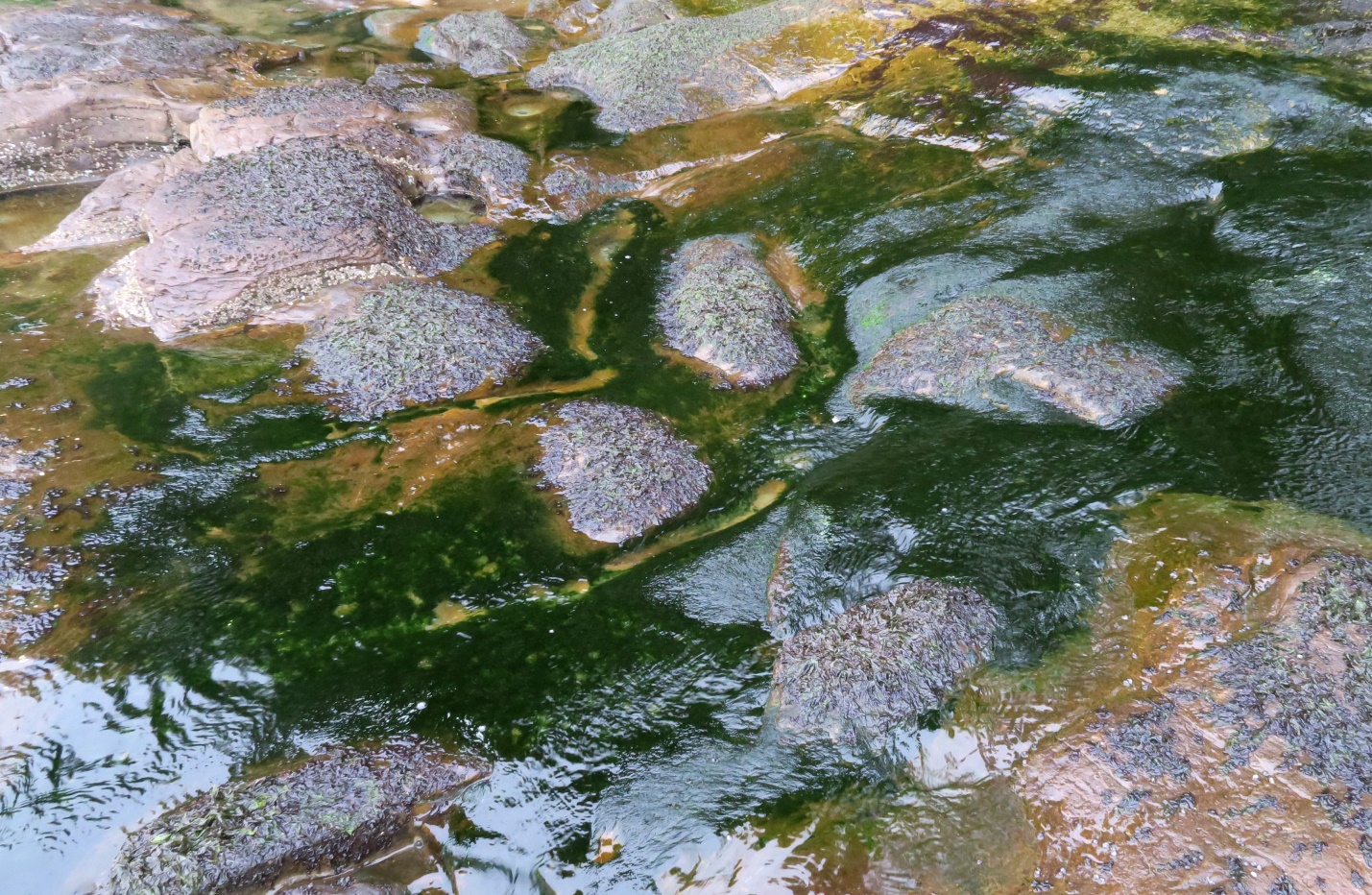
Figure 1: This overview photo of the sandstone shelf, and the freshwater stream that pours over it in the rainy winter months in this region, shows the bright green presence of Ulothrix flacca. It is profusely growing here, and loves the fresh water that hydrates it when the tide is out. French Beach, Juan de Fuca Strait, B.C., Canada. February 5, 2024. Photo ID 27624 ©Seaweedwhisperings.com
The first thing I put down I also decided (at the time) to cross off.
I put Ulothrix flacca, then Pyropia fallax, and then this one point which I think might still be valid – “seems to be pair”. The next morning, when I saw the photograph Person 2 showed me that was taken by a phycologist from Japan (which pictured these same two seaweeds growing side-by-side in a very similar way to what we saw at French Beach), that brought this thought back – “seems to be a pair”.
At this location U. flacca likes to have a constant stream of fresh water as the tide recedes.
In the stream it looks like wetted down fine hair.
Single threads are delicate, maybe fragile, but when in the group they form a strong unified presence.
Might not be able to survive alone, but can thrive with the momentum of the group.
Can’t think for themselves?
Needs the support or approval from others?
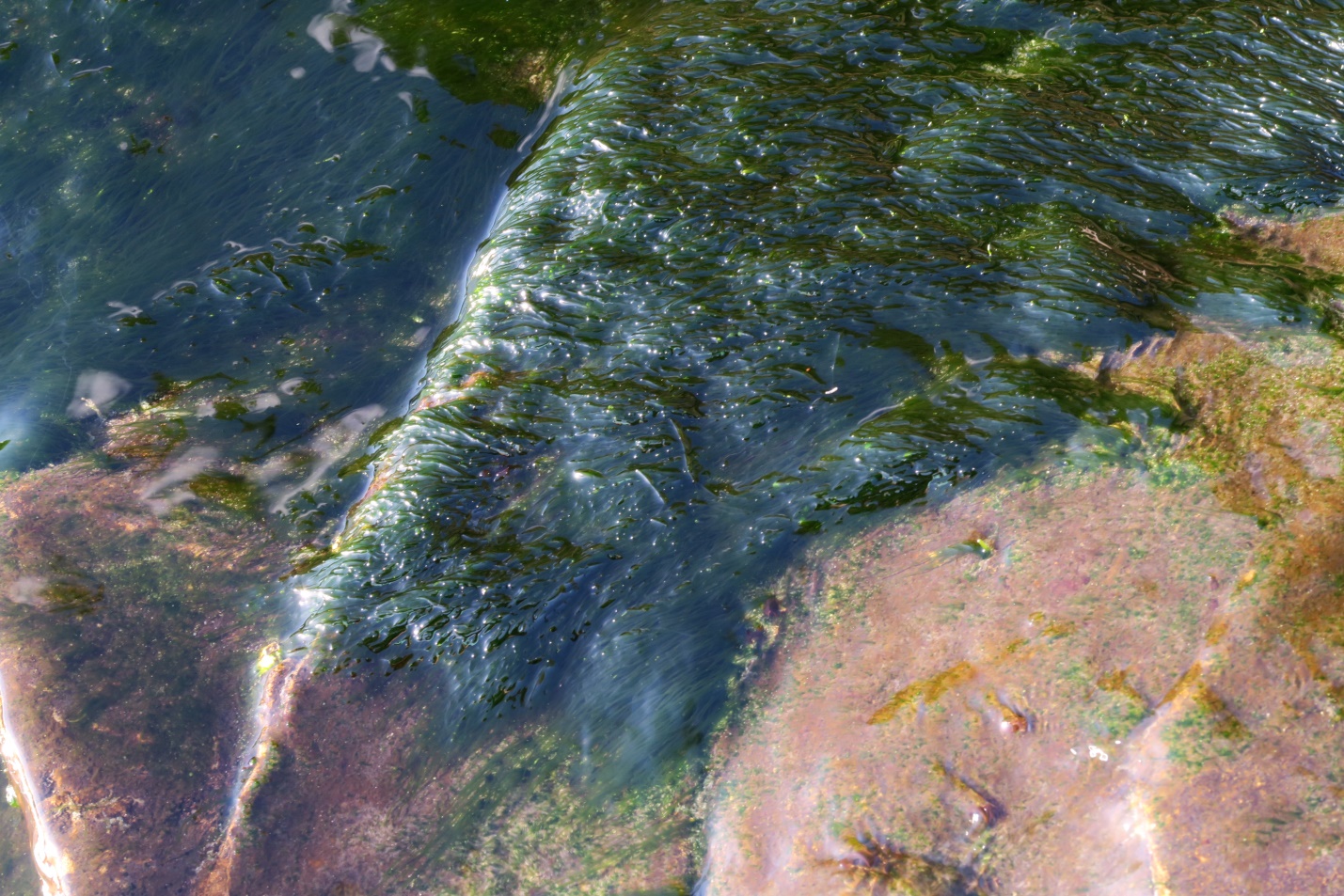
Figure 2: Mermaid’s Tresses – long locks of hair, are viewed here showing their lovely green color. They shine with vitality in the blend of water and sunlight available on this late winter afternoon. French Beach, Juan de Fuca Strait, B.C., Canada. February 5, 2024. Photo ID 27625 ©Seaweedwhisperings.com
Person 2:
In this place where fresh water runs down from the forest and pours over the sandstone rock shelf, there is a special high intertidal area. What I first notice today is the sound. I hear fresh water burbling over the rocks in a constant gentle chatter of notes. And I hear rhythmic ocean swells crashing to the timing of the ocean’s pulse.
Two prominent sounds.
Two notable influences.
Two obvious seaweeds living here.
Let’s see if they both will ‘whisper’ to us. It seems almost ‘wrong’ to separate them or only listen to one of them.
Of these two seaweeds, one is a red algae; it is called Pyropia fallax. The other is a green algae, and it is named Ulothrix flacca.
Taking an overview it is clear that Ulothrix likes to be just that much wetter. It is growing here in profusions of regularly sized simple green fronds and always far more profusely in the areas where the freshwater pools and lingers a while on its way to the ocean. At times of rougher seas or higher winds, these same deeper crevices or pools would be a mix of salt water and fresh.
Ulothrix loves the water – even the fresh water seeps that at this season are stream-like in quantity.
This seaweed looks richly green, deeply and richly green.
And its simple hair-like blades are long and narrow, but only so long, and these blades all move with the direction of the flow of the water it so loves.
Compliant? Yes, in that it knows to obey the ‘rules’ and the ‘force’ of the water.
So it has a compliant nature; acquiescent..., amenable..., yes, maybe these traits, also. But while Ulothrix doesn’t protest the force/rules of the water’s flow, it actually rejoices in it! The simple strands move with the flow of water and become gently curving green lines that shift and waft and wave whenever forces around them shift or change. There is no “sharpness” to this grouping of gentle moving green curves.
What a lovely trait – to recognize a greater force and one’s inability to change it, so you find the joys, or at least contentment, in living with it.
And Ulothrix doesn’t live alone. There are many, many, many others of its kind all thriving at this season and in this place.
Out of water this seaweed dries a bit lighter in color and deeper in water it looks to be a rich kelly green. The blades only grow to about 10 centimeters long at the maximum. In places here we can find much shorter ones, but nothing much longer.
The multitudes of green blades do not even hint at tangling with each other. They look like they slide alongside each other without any grabbing or clinging to each other. There is no sign of tangling.
I wondered how they would be if the surf crashed up high here and contradicted the flow of the fresh water out of the forest; how would these Ulothrix blades react? I still had difficulty thinking of them getting too tangled. Certainly their orientation, each to another, would become far less uniform, but I think they’d have no capacity to knot up and hold on to each other. They’d quickly settle back into their “sliding alongside” formation. Perhaps they prefer this way of being, and so by growing high up in the intertidal zone, they avoid crashing waters much of the time and this helps the group keep its order, avoiding aggression and dissent that is uncomfortable to their nature.
We’ve noted this seaweed here for many weeks now. It loves to grow in the winter/spring season in our area. And it is a vibrant green presence at this time of year when most life is grey looking and dormant. This day of our Whispering, many of the Ulothrix blades were longer than witnessed earlier this growing season. A natural progression for them, surely? And at the tips of many I noticed this time that the green faded out to whitish grey. Something different is going on at the tips now..., maybe a type of aging and wearing, or maybe a type of reproductive effort – I don’t know. This was not visible in December or January at this location with this species so it is likely to be something to do with maturity or seasonal decline.
Stepping around to view some other areas filled with Ulothrix flacca I have to be extremely mindful of where I put my feet. To step on this seaweed is like stepping on grease – and one would certainly slip and slide and lose one’s footing. I realize this is almost like the seaweed ‘inviting’ any vertically-oriented interlopers to join them in their way of being – horizontally “sliding alongside”. I also see that it could be a protective effect. I think much walking on these patches of green algae would rip them from their holds and damage them significantly. So, by living high up in the intertidal they do need to have some concern for terrestrial visitors and some means to keep these visitors from causing harm. Such an incredibly slippery covering certainly keeps human feet effectively distant.
On the day after our interactions I felt the need to do some checking that I had identified this seaweed properly. Many of these green algae are difficult to know with accuracy by field identification methods. So, I found myself spending a bit of time reviewing steps I’ve traced before, when I first found this seaweed and identified it. I wondered if this effort of mine was reflective of the energy of this seaweed – one where there is hesitancy to state an opinion. Maybe even a total preference to not state one at all, but if there is a need to, then it would only come if you’ve had fully enough time to carefully think through and be clear on it.
It is interesting that I felt it would be good to ‘listen’ to both Ulothrix flacca and its abundantly present neighbor here, Pyropia fallax, today. For Ulothrix the proximity of others is noted but they don’t even try to relate (with those others). This green seaweed is rather too timid to really try to “mix” with others, and it is also quite well occupied enough, thank you very much, with their life necessities. Things can get to feel quite complicated and easily “too much” for Ulothrix, so they are happy to keep to their own groupings and their watery sliding-on-by way of being.
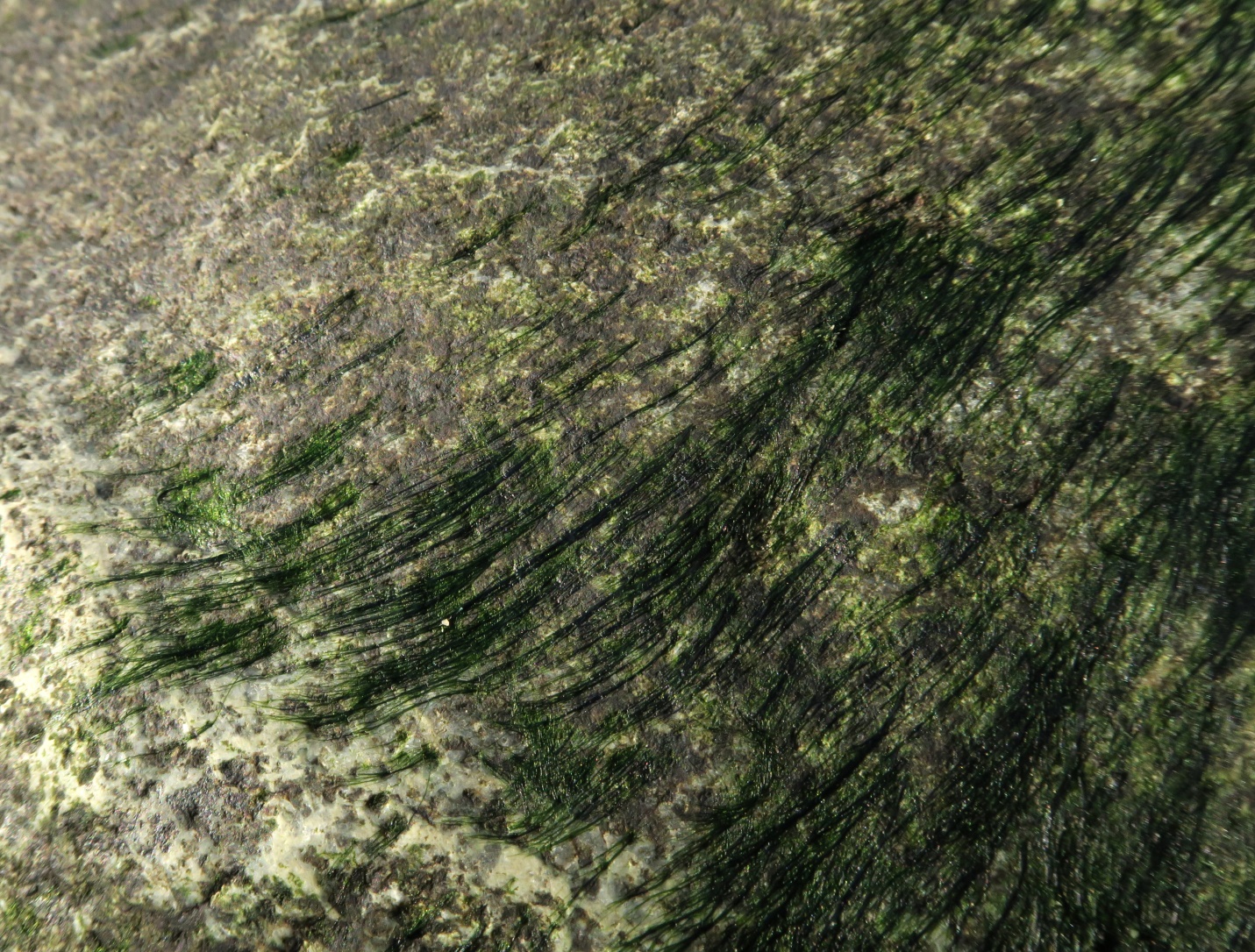
Figure 3: The filaments of Ulothrix flacca become hard and brittle when dry. On this medium sized boulder this drying is under way and this defines the individual hair-like blades distinctly. Jordan River, Juan de Fuca Strait, B.C., Canada. December 23, 2023. Photo ID 27626 ©Seaweedwhisperings.com
Discussion:
Ulothrix shifts and moves whenever the stronger forces around them do. So by their very nature they innocently reveal the ‘temperament’ of stronger ones nearby. Ulothrix won’t run out to protest injustice, or partake in conflict, and abhors the idea of engaging in aggressive acts. They don’t outwardly oppose but instead they shift and bend and avoid, preferring whenever possible to add none of their energy to aggression. However they do not always know that they can be a very accurate mirror, reflecting the nature of the energy around them.
There was gentleness in the action of the freshwater stream that was flowing over many of the Ulothrix strands on the day of our interaction. While that may be dismissed as a temporary condition, it actually felt like more than that – it was a perfect circumstance to highlight how the energy of this seaweed loves to be. Ulthorix is a seaweed that enjoys gentle movement and an unhurried pace. In fact Ulothrix can easily get tangled up, overwhelmed and pushed well out of its comfort zone if it somehow finds itself in any kind of race or demand to meet a specific deadline.
Also true to this seaweed is that they have their own opinions, deep and true – just like the richness of their green coloration, but they are rarely forthcoming with those opinions. This can be thought of as kind of timidity or may be interpreted as a sense of inferiority or as if they “can’t think for themselves”, but often it is a result of Ulothrix’s need to go over things for themselves, twice, three times, as many times as needed, and then, only then, will they offer their opinion. They take great care, and such care means they often have a valuable contribution to make when they do share their thoughts.
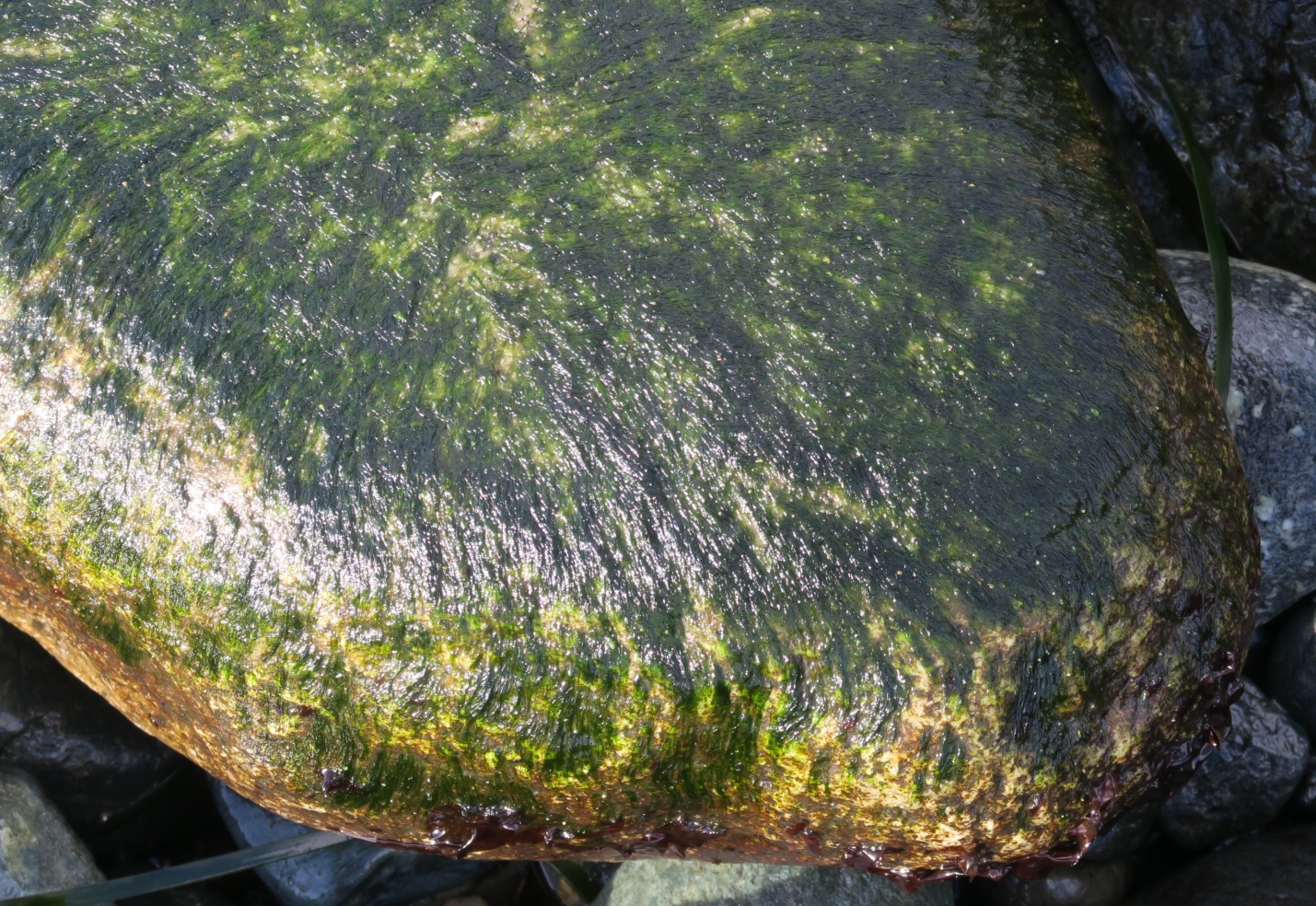
Figure 4: When wet, the blades of this seaweed do not tangle so much but appear to merge or coalesce into a dark green slippery mass – the common name “Flabby Shaggy Hair Weed” is apt when this green alga is wet! Jordan River, Juan de Fuca Strait, B.C., Canada. December 23, 2023. Photo ID 27627 ©Seaweedwhisperings.com
Biology & Natural History Information:
Description:
Thallus is composed of dark green unbranched hair-like filaments with a single file (uniseriate) of cells 1 to 10 cm in length. The filaments are gregarious and can form bright green strings or entangled mats and dense coverings or turfs on a variety of shoreline substrata that look coalesced and dark green in color. Filaments are attached to the substrata by rhizoids formed on the basal cell. The texture of this alga when wet is soft and hair-like but becomes hard and brittle when dry. The cells have a single nucleus, and although narrow, they are shorter than wide. The single collar-shaped chloroplast fills the length of the cell but not the full circumference. Plants become reproductive in the distal part, and are considerably swollen when fertile, reproductive cells swell up to 50 µm diameter (non-reproductive diameter is 14-33 µm).
Habitat:
This species forms a very slippery coating on rock in the mid to high intertidal zone in the protected to semi-exposed areas and occurs also in pools and in areas of freshwater outflow, in winter-spring or spring-early summer, depending on the locale. Ulothrix species often occur with other hair-like green seaweed species including Calothrix, Urospora, Chaetomorpha and Rhizoclonium. It is noted to occur on a wide range of substrata.
World Distribution:
Widely distributed in temperate regions. Arctic Ocean from Ellesmere Island through to Long Island Virginia and Florida; Argentina. Also recorded from east Greenland, Iceland, Norway to Portugal, the Mediterranean, Africa; the Bering Sea and Aleutian Islands, Alaska, to southern California; Chile; Korea; Japan; Russia; New Zealand and some Antarctic Islands.
Remarks:
The type location for this species is Swansea, Wales, Britain (Guiry and Guiry 2013). Origin of the species name, ‘flacca’ is from the Latin adjective meaning “drooping”.
Classification:
Phylum: Chlorophyta
Class: Ulvophyceae
Order: Ulotrichales
Family: Ulotrichaceae
Genus: Ulotrhix
Species: Ulothrix flacca (Dillwyn) Thuret 1863
Former name(s): Conferva flacca Dillwyn 1805.
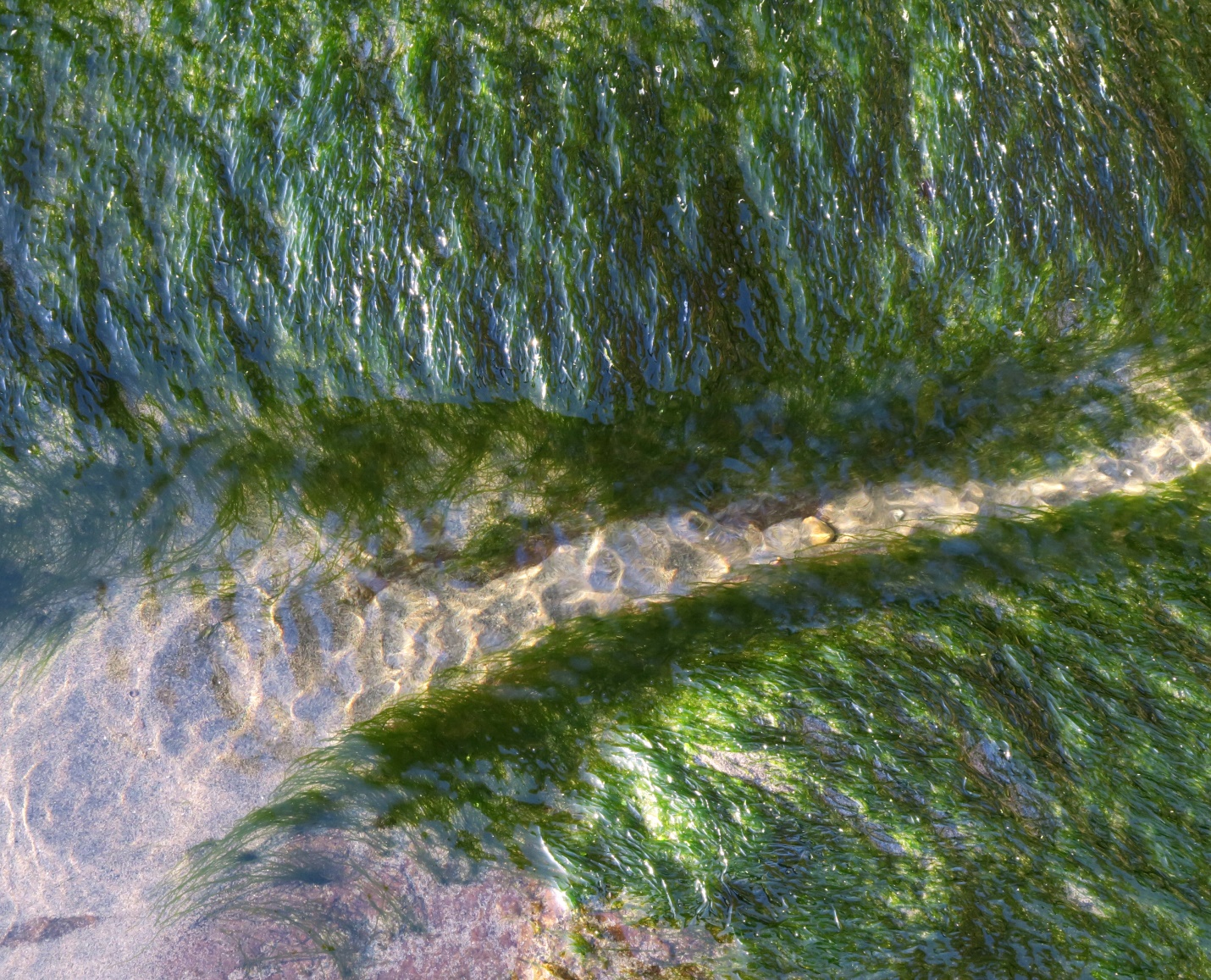
Figure 5: Another view of Ulothrix flacca growing where conditions are favorable; the green threads glisten when wet but dry quickly if exposed. In this location at the winter/spring season they are rarely exposed during daylight hours so the risk of sun-drying is low; wind drying is another factor, but the winter/spring season is also the rainy one here, so there can often be fresh water to keep Mermaid’s Tresses moist if the tides cannot. French Beach, Juan de Fuca Strait, B.C., Canada. December 23, 2023. Photo ID 27628 ©Seaweedwhisperings.com
![]()